UPSC Daily Current Affairs- 7th August 2023 | Current Affairs & Hindu Analysis: Daily, Weekly & Monthly PDF Download
GS-II
India – United Kingdom Bilateral Relationship
Subject: International Relations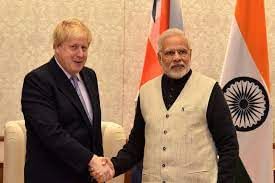
Why in News?
India and the UK are very close to concluding negotiations for the proposed Free Trade Agreement (FTA) and discussions on 19 out of total 26 chapters have been closed.
India – UK Bilateral Relationship:
- India and the UK share a strong and multi-dimensional strategic partnership.
- Following India’s economic reforms in the early 1990s that placed the Indian economy on a high growth trajectory, the two countries have taken several initiatives to expand bilateral relations.
- India's multifaceted bilateral relationship with the UK intensified with its up-gradation to a Strategic Partnership in 2004.
- To advance trade and investment relations, they have formally launched negotiations for a free trade agreement (FTA) in January, 2022.
Economic and Commercial Relations:
- Total trade in goods and services (exports plus imports) between the UK and India was USD 32.7 billion during the period from April 2021 to March 2022.
- Total exports from India to UK amounted USD 21.5 billion while imports from UK to India amounted USD 10.2 billion.
- India has a trade surplus relationship with the UK.
- The UK is the 7th largest export destination for India.
- India is also the 2nd largest source of FDI for the UK.
- India’s major exports to UK –
- Ready-made garments and textiles, gems and jewellery, engineering goods, petroleum and petrochemical products, transport equipment and parts, spices, manufactures of metals, machinery and instruments, drugs & pharmaceuticals and marine products.
- In the services sector, the UK is the largest market in Europe for Indian IT services.
- India’s major imports from UK –
- Precious and semi-precious stones, meta lifers, ores and metal scraps, engineering goods, professional instruments other than electronics, non-ferrous metals, chemicals and machinery.
Indian Diaspora in the UK:
- Indians make up around 2.86% of the United Kingdom's population.
- As per the UK Census 2021, Total Indian Population in the United Kingdom is around 19 Lakh or 1.9 million.
- The UK is the largest source of European remittances to India.
Challenges Involved in India – UK Free Trade Agreement:
- FTAs are arrangements between two or more countries or trading blocs that primarily agree to reduce or eliminate customs tariff and non-tariff barriers on substantial trade between them.
- Following are the major roadblocks impeding the signing of a FTA between India and the UK.
- Services & Investment –
- The UK wants India to liberalize its highly protected services markets in telecommunications, finance, and legal services.
- However, India remains apprehensive due to opposition at domestic level.
- As both countries are large services exporters, a deal without considerable services liberalization may be a shallow FTA.
- Significant complementarity between the services exports of both countries means the negative impact of liberalization on homegrown businesses would be reduced.
- Temporary Movement –
- India is looking for simplification in the UK’s business and temporary visas for professionals.
- Recently on the sidelines of the G20 summit in Indonesia, PMs Narendra Modi and Rishi Sunak agreed to a reciprocal Young Professional visa scheme that will offer a place to degree-educated young Indians the right to live and work in the UK (and vice-versa) for up to 2 years.
- Building on this, additional easing in immigration rules could focus on the IT and healthcare sectors.
- Data Policies –
- Data protection is a major concern for UK firms that may operate in India under the FTA due to the absence of GDPR like protection in India.
- India should implement the Digital Personal Data Protection Bill 2023 that is pending in the Indian parliament. Recently, the Lok Sabha passed the Bill.
- This will be an important step towards better data protection and meeting the UK business standards.
- IPR and Medicines –
- The leaked intellectual property rights (IPR) chapter of the FTA calls for the harmonization of intellectual property (IP) regulations, especially patent laws in the UK and India.
- Such relatively strict laws could affect the provision of affordable and life-saving generic medicines in India.
- Agriculture –
- Agriculture is a sensitive sector in both countries.
- The UK is a net agricultural importer and an FTA could boost India’s agricultural export share from just 1.1% in the UK’s import basket for goods like rice, marine products, spices and bovine meat.
- India could revisit its apprehensions about allowing British food imports, especially with its expanding middle class that is willing to spend on higher-value added agri-based food products.
- To compensate farmers for losses from increased British imports, India could establish a structural fund like those of the EU, and the UK could contribute aid-for-trade.
News Summary:
- Of the 26 chapters or policy areas that are being discussed between India and the UK to sign a FTA, 19 have been closed for negotiations.
- In the recently concluded 11th round of talks, both countries have been able to reach broad consensus on matters related to automobiles, whisky and market access.
- The negotiations for the India-UK FTA are likely to be concluded much before the end of this year.
- The negotiations for the FTA between the two countries had slowed down after the economic and political crises in the UK.
- The overarching focus from India’s perspective is to ensure a comprehensive deal without ceding too much ground, as it will serve as a template for all upcoming trade pacts.
- FTAs are being discussed with the EU (European Union) and the EFTA (European Free Trade Association) countries viz., Iceland, Liechtenstein, Norway and Switzerland.
Source: Economic Times
Amrit Bharat Station Scheme: PM launches in 13 railway stations under the scheme
Subject: Polity and Governance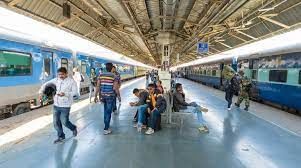
Why in News?
The PM launched work on the rejuvenation of 13 railway stations in Karnataka under the Amrit Bharat Station Scheme (ABSS).
What is the Amrit Bharat Station Scheme (ABSS)?
- About:
- Launched in February 2023 by the Ministry of Railways, the ABSS envisages the development of stations on a continuous basis with a long-term approach.
- The scheme was launched to redevelop 1,309 stations across the country and is based on Master Planning for long term and implementation of the same as per needs and demand of the station to station.
- Need:
- India Railways is an integral part of the nation’s transportation infrastructure.
- In a bid to keep it safe for passengers as well as freight transportation, it is essential to modernise its infrastructure with latest technologies, amenities and others from time to time.
- In this context, the government is working to transform the railway stations across the country in line with its vision of ‘Naya Bharat’/ New India.
- Objectives of the ABSS:
- The ABSS aims at enhancing the facilities beyond the Minimum Essential Amenities.
- It also aimed at construction of Roof Plazas and City Centres at the station.
- It caters for the introduction of new amenities as well as upgradation and replacement of existing amenities.
- Scope of work under ABSS: The ABSS involves improvement of amenities at the stations like -
- Entry and exit, circulating areas, waiting halls, toilets, lift/escalators, cleanliness, free Wi-Fi
- Kiosks for local products through schemes like ‘One Station One Product’
- Better passenger information systems
- Executive Lounges
- Nominated spaces for business meetings, landscaping, etc.
News Summary Regarding Launch of Recent Rejuvenation Works under ABSS:
- The 13 railway stations include Ballari, Ghatprabha, Gokak Road, Alnavar, Gadag, Koppal, Harihar, Arsikere, Mangaluru Jn., Wadi, Kalaburagi Jn. (Gulbarga) and Shahabad.
- These railway stations in the State are all set to emerge as city centre and urban icons giving a new identity to the town/city in which they are located.
- The stations will become world class with amenities such as a shopping zone, food court, children’s play area, multi-level parking, physically challenged-friendly facilities, etc.
- With the integration of multi-modal connectivity, the redeveloped stations will become the centre of socio-economic activities of the region.
- The launch of these 13 stations was part of the all-India launch of laying the foundation stone for work on 508 stations in various States.
- The PM said that ABSS is set to transform and revitalise 1,309 railway stations across the nation and will breathe new life into travel hubs and enhance the overall passenger experience.
Source: The Hindu
Cabinet approves ₹1.39 lakh crore for BharatNet project
Subject: Polity and Governance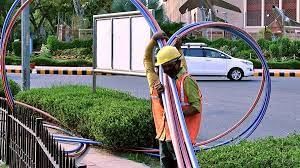
Why in News?
The Cabinet has given its approval for an outlay of ₹1.39 lakh crore for the BharatNet project, aimed at providing last-mile connectivity to around 6.4 lakh villages across India.
About BharatNet Project
- Objectives: The project aims to connect 6.4 lakh villages, covering all gram panchayats in the country, with last-mile broadband connectivity through optical fiber.
- Implementation: Bharat Broadband Network (BBNL), a special purpose vehicle under Bharat Sanchar Nigam Limited (BSNL), is responsible for executing the project.
- Tie-up with VLEs: BBNL will collaborate with village level entrepreneurs (VLEs) to provide connectivity, following a successful pilot project in four districts and later expanded to 60,000 villages.
- Progress So Far: As of now, around 1.94 lakh villages have been connected, and the rest are expected to be covered in the next 2.5 years.
Services details
BharatNet is the world’s largest rural connectivity scheme with an Optical Fibre network.
- Gram Panchayat: The scheme aimed to provide 100 Mbps broadband to 2.5 lakh gram panchayats.
- Households: The main goal is affordable 2 Mbps to 20 Mbps broadband for all households, especially in rural areas.
Key Achievements of the Project
- Broadband Connections: The pilot project involved 3,800 entrepreneurs providing 3.51 lakh broadband connections to villages.
- Data Consumption: Households in connected villages recorded an average data consumption of 175 gigabytes per month.
- Pricing and Speed: The project is based on a 50% revenue share between BBNL and VLEs, offering monthly broadband plans priced from ₹399 to ₹799 with a minimum speed of 30mbps.
- Optical Fiber Laid: Currently, there are 37 lakh route kilometers (rkm) of optical fiber cable (OFC) laid in India, with BBNL contributing 7.7 lakh rkm OFC to the network.
Source: The Hindu
Jeddah peace summit on the Russia-Ukraine war
Subject: International Relations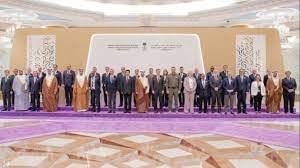
Why in News?
Saudi Arabia hosted Ukraine, the U.S., some European countries and major developing countries including India and Brazil for peace talks on the Russia-Ukraine war.
- The aim of this summit was to reach an agreement on key principles for a peaceful end to Russia's war in Ukraine.
What is the Background of Russia-Ukraine conflict?
- Tensions between Ukraine and Russia escalated in late 2013 over a landmark political and trade deal with the European Union.
- After the pro-Russian then-President, Viktor Yanukovych, suspended the talks weeks of protests in Kyiv erupted into violence. Soon, the then pro-Russian President was ousted.
- Russia responded by invading Crimea, which was a part of Ukraine, and annexing it in March 2014.
- Russia invaded Crimea on the pretext that it was defending its interests and those of Russian-speaking citizens.
- Shortly afterwards, pro-Russian separatists in Ukraine's Donetsk and Luhansk regions declared their independence from Kyiv (capital of Ukraine).
- They established their own autonomous state called Donetsk People's Republic in 2014.
- Russia, in February 2022, recognised the independence of these two regions.
- Kyiv and Moscow signed a peace deal in Minsk in 2015. It was brokered by France and Germany. But it could not bring peace in the region.
- Later, in February 2022, Russian President Vladimir Putin declared war on Ukraine in a televised address.
- He said the military action announced by Russia will seek to demilitarize Ukraine and came in response to threats from Ukraine.
Why Russia invaded Ukraine?
- Russia wanted a guarantee that Ukraine can never join NATO
- Russia's main demand was a commitment from NATO to end its further expansion into former Soviet republics — especially Ukraine.
- Russia wants NATO arms out of Eastern Europe
- Russia wants NATO to stop deploying its weapons and forces in countries in Central and Eastern Europe that joined the alliance after 1997.
- Russia wants a ban on NATO missiles within striking distance
- Russia has nervously watched as NATO has demonstrated deepening its involvement in Ukraine — providing weapons and training.
- NATO missiles on Ukrainian soil might pose serious threat to Russia’s security.
- Russia wants autonomy for eastern Ukraine
- Russia says Ukraine must meet its obligations under 2015 agreements.
- The peace deal, known as the Minsk agreements, was signed to end the fighting between Ukraine's army and pro-Russian separatists in eastern Ukraine.
- The Minsk agreements also provided additional autonomy to the separatist Russian-speaking territories in the Donbas.
- Russia says Ukraine must meet its obligations under 2015 agreements.
News Summary: Jeddah peace summit on the Russia-Ukraine war
- The two-day meeting on the Ukraine conflict was hosted by Saudi Crown Prince Mohammad Bin Salman and attended by top security officials of around 40 countries.
- The current meeting follows an earlier meeting in Copenhagen more than a month ago to discuss the Russia-Ukraine conflict.
- While Russia did not participate, Ukraine was present at the meeting. India was represented by NSA Ajit Doval.
Key highlights of the speech delivered by NSA Doval
- Underlined the need for respect for sovereignty and territorial integrity by all states
- He emphasised that respect for sovereignty and territorial integrity by all states must be upheld without exception.
- He also said that efforts must be made to resolve the conflict and soften its consequences.
- Highlighted the challenges
- The meeting confronts a two-fold challenge — resolution of the situation and softening the consequences of the conflict.
- Efforts must be directed on both fronts simultaneously and much more groundwork is needed to ensure this.
- A solution acceptable to all relevant stakeholders is needed to end the war
- He said that several peace proposals have been put forward, and each has some positive points but none is acceptable to both sides.
- Ukrainian President Zelenskyy had proposed 10-point peace plan during last year’s G-20 summit.
- China also came up with a 12-point-plan for the political settlement of the Ukraine crisis.
- In June 2023, leaders of seven African countries, led by South African President Cyril Ramaphosa, visited Russia and Ukraine.
- They proposed a 10-point proposal which suggested the recognition of Russia and Ukraine's sovereignty, and the release of prisoners.
- The key question that needs to be addressed in this meeting is whether a solution acceptable to all relevant stakeholders can be found.
- Highlighted India’s approach
- He said that India’s approach has been and always will be to promote dialogue and diplomacy. This is the only way forward for peace.
- India has engaged both Russia and Ukraine since the beginning of the conflict at the highest levels.
- While India has not explicitly condemned the Russian invasion of Ukraine, PM Modi had said this is not the era of war.
- India has also condemned the Bucha massacre, expressed concerns at the nuclear rhetoric by the Russian leadership.
- In recent days, India condemned the collapse of the Black Sea Grain Initiative, where Russia walked out of the deal.
- He also pointed out that the whole world and especially the Global South was bearing the brunt of the situation.
- New Delhi is providing both humanitarian assistance to Ukraine and economic assistance to its neighbours in the Global South.
- He said that several peace proposals have been put forward, and each has some positive points but none is acceptable to both sides.
India’s participation: what does it signify?
- NSA Ajit Doval’s participation in the peace conference on Ukraine shows India’s willingness to step up efforts to end the war.
- It has raised its level of representation — up from the Secretary-rank official in June — reflects the sense of purpose on India’s side.
- In Copenhagen meet, where Ukraine was on the agenda, India was represented by MEA’ Secretary (West).
- As chair of G20, New Delhi is keen to have a consensus document at the leaders’ summit in New Delhi next month.
Source: AIR
GS-III
ISRO Rocket Debris on Australian Shore
Subject: Science and Technology

Why in News?
A couple of weeks ago, a large object discovered on the shores of Western Australia has been confirmed to be the debris of an ISRO rocket used for IRNSS constellation.
- The incident raises concerns about space debris and its potential impact on Earth and its inhabitants.
Frequency and Risks of Space Junk
- Common Occurrences: Incidents of space debris falling back to Earth are not uncommon. Most instances involve relatively small fragments that survive atmospheric friction, typically not making significant news.
- Publicized Instances: However, there have been a few highly publicized falls, such as a 25-tonne Chinese rocket chunk falling into the Indian Ocean in May 2021 and the disintegration of the Skylab space station in 1979, with some fragments landing in Western Australia.
How did ISRO debris land in Australia?
- Probable Re-entry and Ocean Drift: The debris likely remained unburnt while dropping back into the atmosphere during re-entry and eventually fell into the ocean. Ocean currents may have carried it towards the Australian shores.
- Move for disposal: The Australian Space Agency is working with ISRO to determine the next steps, including considering obligations under the United Nations space treaties.
Potential Hazards and Impact
- Threat to Life and Property: The threat to life and property from falling space junk cannot be ignored. Even objects falling into oceans can pose risks to marine life and contribute to pollution.
- Recorded Incidents: So far, there are no recorded incidents of falling space objects causing significant damage on Earth. Instances of debris falling over land have generally occurred in uninhabited areas.
International Regulations and Liability
- Convention on International Liability for Damage Caused by Space Objects: International regulations, such as this Convention, govern issues related to space debris falling back to Earth.
- Absolute Liability: The launching country is “absolutely liable” to pay compensation for any damage caused by its space object on Earth or to a flight in the air.
- Compensation Provision: In the current case, if the PSLV debris had caused any damage in Australia, India could have been liable to pay compensation, regardless of it falling into the ocean first.
- Past Compensation: The Convention has resulted in compensation payment only once when Canada sought damages from the Soviet Union for a satellite with a radioactive substance falling into its uninhabited northern territory in 1978. The Soviet Union paid 3 million Canadian dollars as compensation.
ISRO’s Efforts to Mitigate Space Debris
- Unique Scientific Experiment: ISRO successfully conducted a dedicated commercial mission, placing seven Singaporean satellites into intended orbits on board a PSLV rocket.
- Orbit-lowering Experiment: During this mission, ISRO performed a unique experiment, lowering the fourth stage of the rocket into a 300 km high orbit after placing customer satellites at an altitude of 536 km to mitigate space debris concerns.
- Reducing Debris Duration: Thanks to the orbit-lowering experiment, the duration of the stage in space has been significantly reduced to “two months.”
- Objectives of the Experiment: The experiment aims to address space debris mitigation problems and preserve valuable orbits for future satellite deployments.
Conclusion
- The incident of India’s space debris washing ashore in Australia highlights the importance of managing space debris to ensure the safety of Earth and its inhabitants.
- ISRO’s efforts to mitigate space debris through conscious measures demonstrate responsible space exploration practices.
Source: The Hindu
Excess Cane Payments
Subject: Agriculture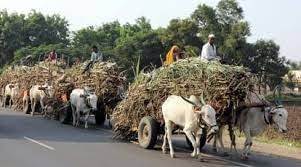
Why in News?
In a significant move, the Government of India has taken a step to provide relief to cooperative sugar mills by allowing them to claim excess cane price payments made to farmers as "business expenditure."
What is the Issue of Excess Cane Payments?
- Sugarcane is a major crop in India, especially in states like Maharashtra, Uttar Pradesh, Karnataka, and Tamil Nadu.
- The Centre fixes a fair and remunerative price (FRP) for sugarcane every year, which is the minimum amount that sugar mills have to pay to farmers for procuring their cane.
- However, some cooperative sugar mills, especially in Maharashtra, pay more than the FRP to farmers as an incentive or bonus. This is called excess cane payment.
- The excess cane payment has resulted in tax disputes between the cooperative sugar mills and the Income Tax Department.
- The mills claim the excess payment as business expenditure, while the department treats it as a distribution of profits and disallows it as a deduction.
How has the Government of India Resolved the Issue of Excess Cane Payments?
- In the 2015-16 Union Budget, the Government of India introduced an amendment to the Finance Act that allowed cooperative sugar mills to claim excess cane payment as deduction for computing their business income. However, this was applicable only from the 2016-17 assessment year onwards.
- In the 2023-24 Union Budget, the Government of India extended the benefit of deduction to all financial years prior to 2015-16. This was done by amending Section 155 of the Income Tax Act .
- The move is expected to provide relief of almost Rs 10,000 crore to cooperative sugar mills, against pending tax demands and litigation in respect of payments made before the 2015-16 financial year.
What is the FRP?
- About:
- FRP is the price set by the government that sugar mills are obligated to pay to farmers for the sugarcane procured from them.
- Payment and Agreement:
- Mills are legally required to pay the FRP to farmers for their cane.
- Mills can choose to sign agreements with farmers, allowing them to pay the FRP in installments.
- Delayed payments can attract interest charges of up to 15% per annum, and the sugar commissioner can recover unpaid FRP by attaching properties of the mills.
- Governing Regulations:
- The pricing of sugarcane is governed by the statutory provisions of the Sugarcane (Control) Order, 1966 issued under the Essential Commodities Act (ECA), 1955.
- According to the regulations, the FRP must be paid within 14 days of cane delivery.
- Determination and Announcement:
- The FRP is determined based on the recommendations of the Commission for Agricultural Costs and Prices (CACP).
- The Cabinet Committee on Economic Affairs (CCEA) announces the FRP.
- Factors Considered:
- The FRP takes into account various factors, including the cost of sugarcane production, returns from alternative crops, trends in agricultural commodity prices, availability of sugar to consumers, selling price of sugar, sugar recovery from cane, and income margins for cane growers.
What is Sugarcane?
- Temperature: Between 21-27°C with hot and humid climate.
- Rainfall: Around 75-100 cm.
- Soil Type: Deep rich loamy soil.
- Top Sugarcane Producing States: Uttar Pradesh, Maharashtra, Karnataka, Tamil Nadu, Bihar.
- India is the second largest producer of sugarcane after Brazil.
- It can be grown on all varieties of soils ranging from sandy loam to clay loam given these soils should be well drained.
- It needs manual labour from sowing to harvesting.
- It is the main source of sugar, gur (jaggery), khandsari and molasses.
- Scheme for Extending Financial Assistance to Sugar Undertakings (SEFASU) and National Policy on Biofuels are two of the government initiatives to support sugarcane production and the sugar industry.
Source: The Hindu
Bhu-Vision
Subject: Agriculture
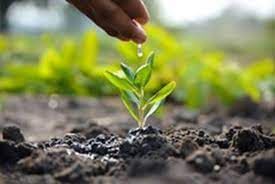
Why in News?
Recently, a revolutionary IoT-based automated soil testing and agronomy advisory platform, Bhu-Vision was officially launched at AICRP (ICAR-IIRR), Hyderabad.
About Bhu-Vision:
- It is also known as KRISHI-RASTAA Soil Testing System.
- It has been jointly developed by ICAR-IIRR(Indian Council of Agricultural Research -Indian Institute of Rice Research) and KrishiTantra.
- This system seamlessly conducts 12 key soil parameter tests in just 30 minutes.
- It provides quick and accurate results directly to farmers and stakeholders through a soil health card on their mobile devices.
Key facts about Indian Institute of Rice Research
- It was established as All India Coordinated Rice Improvement Project (AICRIP) by the Indian Council of Agricultural Research (ICAR) in 1965.
- Headquarter: Hyderabad.
- Mandate
- Basic and strategic research for enhancing rice productivity under irrigated ecosystem
- Coordination of multi-location testing to develop location specific varieties and technologies for various ecosystems.
- Dissemination of technologies, capacity building and establishing linkages
Source: Times of India
Indian Eagle Owl
Subject: Environment and Ecology
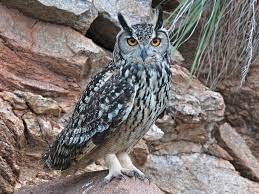
Why in News?
The Indian eagle owl was recently classified species distinct from the Eurasian eagle owl.
Indian Eagle-Owl
- The Indian eagle-owl or rock eagle-owl, is a large horned owl species native to hilly and rocky scrub forests in the Indian Subcontinent.
- It is splashed with brown and grey, and has a white throat patch with black small stripes.
- Conservation Status: Least Concerned (IUCN), Appendix II (CITES)
Key features
- Distinct Species: Classified separately from the Eurasian eagle-owl, the Indian eagle-owl stands out with its imposing size, reaching up to two and a half feet in length and six feet in wingspan.
- Nocturnal Secrets: Due to its nocturnal nature, limited knowledge is available about the bird, contributing to its aura of mystery.
- Menacing Appearance: Prominent ear tufts resembling horns may have evolved to deter predators, giving the bird a threatening appearance.
Threats from Superstitions
- In rural India, the bird is considered a bearer of ill omens, and its loud double-hoot calls are linked to superstitions.
- Folklore suggests that when trapped and starved, the Indian eagle-owl could speak in a human voice, foretelling the future of its listeners.
Ecological significance
- The Indian eagle owl’s diet of rodents, including rats and bandicoots, aligns well with open scrublands and agricultural regions, making it beneficial for farmers.
- Owls nesting near agricultural lands have shown higher numbers of healthier owlets due to the abundance of rodents.
Source: The Hindu
|
63 videos|5408 docs|1146 tests
|





















